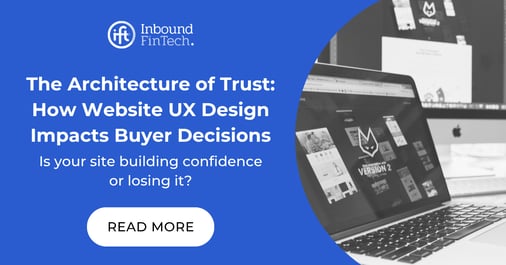The Architecture of Trust: How Website UX Design Impacts Buyer Decisions
Discover how website UX design influences trust, shapes buyer perceptions, and drives conversions. Is your site building confidence or losing it?
Innovation Director at Inbound FinTech Mihai Jepan is the Innovation Director at Inbound FinTech.

..
Why First Impressions Start With UX (Not Just a Fancy Logo)
You've got seconds. Not minutes. Seconds.
That's all it takes for someone to decide whether your business is credible or just another site they'll click away from.
It's not just your logo or your snappy headlines. It's everything. All working together to shape perception before a single scroll or click.
Your website isn't a digital business card. It's your brand's handshake, elevator pitch, and showroom, rolled into one. And when it comes to converting browsers into buyers, one of the most underrated heroes is UX design.
UX is the stuff that makes a site not just look good, but makes it feel right.
Trust Starts With Design
We humans are a judgy bunch. We size things up in milliseconds. And online? It's even faster.
A 2020 Stanford study found that 75% of users judge a company's credibility based solely on web design. That's huge.
Here's the thing: good UX isn't just about sleek fonts or trendy colour palettes. It's about creating an experience that feels intuitive, trustworthy, and unmistakably represents your brand.
Because when your site feels purposeful and easy to navigate, people stick around. They click. They trust.
That's what turns visitors into leads-and leads into loyal customers.
UX and the Psychology of Trust
Let's get geeky for a second.
Trust is built on predictability, safety, and empathy and UX design delivers all three, when done right:
- Predictability: Is the user journey smooth and logical? Can people easily find what they're looking for without needing a digital compass?
- Safety: Does the design feel secure, with SSL certificates, clean navigation, and reassuring UI signals like badges, testimonials, or client logos?
- Empathy: Does the experience show the brand understands the user's needs, frustrations and goals?
If you're missing even one of these layers, you're likely losing prospects.
What Distrust Looks Like
Here's the harsh truth: many websites unintentionally push users away. Some common UX red flags?
- Confusing navigation or poor mobile responsiveness
- Slow loading times (hello, back button)
- Generic or outdated design: Instantly perceived as "unprofessional"
- Lack of clear CTAs or worse, too many conflicting ones
- No social proof: no testimonials, logos, case studies, or real-life wins
Buyers today are discerning. They've seen enough bad UX to recognise when something feels "off", even if they can't articulate it. Trust, in this case, is as much about removing friction as it is about adding flair.
The Buyer Journey is Emotional
Here's a question:
How does your website make people feel?
Because yes, people still buy based on emotion and justify with logic. Trust breeds comfort. Comfort leads to engagement. Engagement unlocks conversion. It's a domino effect. But it starts with emotion.
Your UX needs to offer subtle emotional cues that speak to your buyer's mindset:
- Clarity for the cautious
- Boldness for the ambitious
- Warmth for the overwhelmed
- Professionalism for the detail-oriented
It's empathy, encoded in design.
Where Strategy Meets Aesthetic: UX That Converts
Let's not forget: UX isn't just about visual appeal but also a part of your growth strategy. A well-architected user experience can:
- Shorten the buyer journey by reducing confusion or hesitation
- Increase lead conversion rates through well-timed CTAs and form UX
- Reinforce brand authority through polished, high-value content design
- Guide users deeper into your funnel through smart page hierarchy and flow
At Inbound FinTech, we've helped countless financial services brands evolve their websites into growth engines and it almost always begins with UX.
So... Is Your Website Earning Trust or Burning It?
We'll leave you with one final thought-provoking question:
If you visited your own website for the first time - would you trust you?
Not "like" you. Not "understand" you. But trust you.
It's a powerful filter for evaluating your UX decisions. If the answer is "maybe," it's time to start thinking about your website as more than a digital asset. Think of it as the architecture of trust and the foundation on which buyer relationships are built.
And if you're not sure where to start? Well, you know where to find us.
Want help auditing or redesigning your website's UX for better conversion and trust?
IFT specialises in smart, strategic web design for financial services brands.
Let's build something your buyers believe in.




.png)